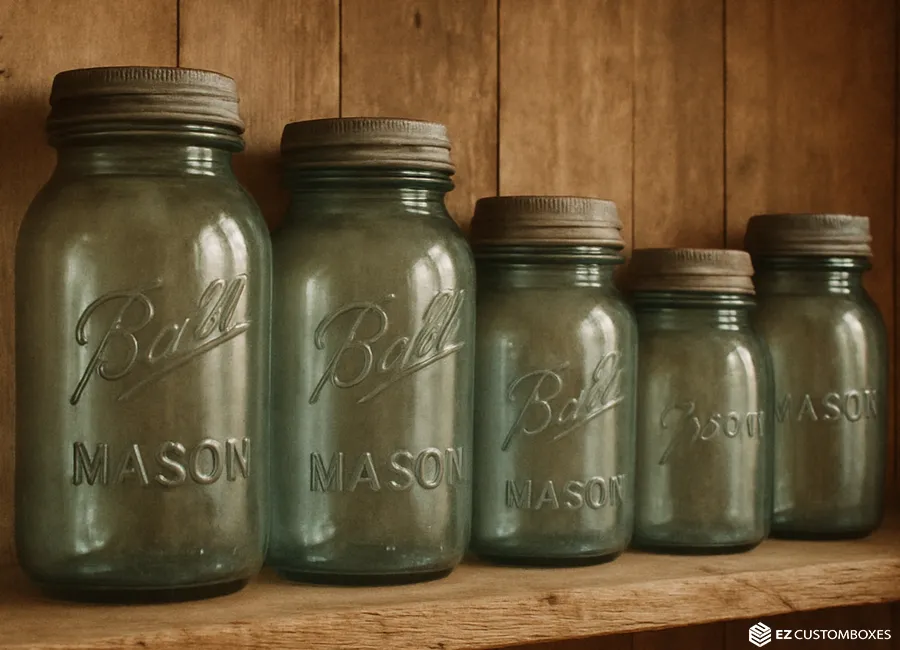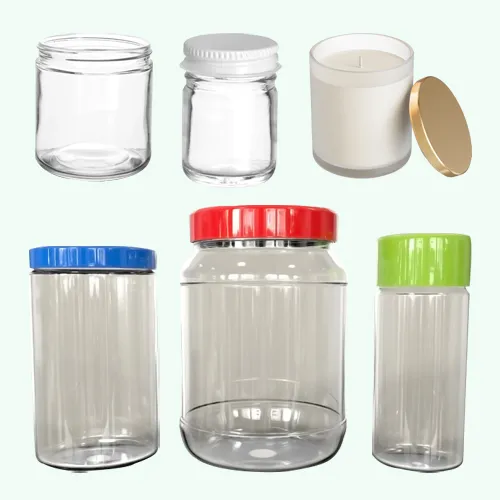Mason jars are more than just glass containers. They are a staple in many homes for storage and decoration. These versatile jars come in various sizes and styles. Understanding mason jar specifications can help you choose the right one for your needs. From canning to crafting, mason jars have a wide range of uses. They are popular among home canners and DIY enthusiasts alike. The history of mason jars dates back to the 1850s. John Landis Mason invented them, and they have been a household favorite ever since. Mason jars are made from tempered glass, making them durable and heat-resistant. This makes them ideal for canning and preserving food. The jars come with a two-part lid system. This design creates a vacuum seal, essential for safe food preservation. Wide mouth mason jars are perfect for storing larger items. They are also easier to clean and fill.
The History and Evolution of Mason Jars
The story of mason jars begins in the mid-19th century. John Landis Mason patented the original design in 1858. His creation was a game-changer for food preservation.
Before the mason jar, food storage was challenging. People relied on unreliable methods that often resulted in spoilage. Mason's invention offered a durable, reusable solution.
Over the years, the design of mason jars has evolved. Innovations in materials and sealing technology improved their functionality. The basic concept, however, has remained the same.
Several key milestones in the evolution of mason jars include:
- Introduction of the two-part lid for better sealing.
- Development of wide mouth jars to accommodate larger items.
- Creation of decorative jars for aesthetic purposes.
Today, mason jars are a cultural icon. They are used for everything from canning to home décor. Their timeless appeal continues to capture the hearts of many.
Mason Jar Sizes: A Complete Guide

Mason jars come in various sizes, each with specific uses. Understanding these sizes helps in selecting the right jar for your needs. Whether for canning, storage, or decoration, choosing the correct size is crucial.
The most common mason jar sizes range from 4 ounces to 64 ounces. These sizes cover a variety of tasks, from preserving jams to storing bulk ingredients. They offer flexibility for both everyday use and special occasions.
Common mason jar sizes include:
- 4-ounce: Ideal for small preserves like jams or jellies.
- 8-ounce (half-pint): Useful for sauces and salad dressings.
- 16-ounce (pint): Perfect for canning fruits or vegetables.
- 32-ounce (quart): Great for pickling and preserving.
- 64-ounce (half-gallon): Suited for bulk storage.
Each size serves a unique purpose. Smaller jars are best for single servings or gifts, while larger jars accommodate bulk storage needs. Selecting the appropriate size ensures optimal storage and preservation.
Mason jar sizes align with canning standards. This standardization guarantees compatibility with canning recipes and equipment. It simplifies the canning process for both novices and experts.
When buying mason jars, consider your intended use. For crafts, smaller jars might be more manageable. For canning, larger jars are often preferred for efficiency.
by Georg Eiermann (https://unsplash.com/@georgeiermann)
Standard Mason Jar Sizes and Their Uses

Standard mason jar sizes cater to diverse needs. Their versatility is one reason for their enduring popularity. Understanding their applications can help optimize your usage.
Pint jars, approximately 16 ounces, are a household staple. They are often used for canning vegetables and fruits due to their convenient size. These jars maintain freshness while fitting neatly on pantry shelves.
Quart jars hold around 32 ounces and are ideal for large batches. Their capacity suits preserving whole fruits or creating sizable sauce batches. They are essential for anyone serious about home canning.
Half-gallon jars provide ample storage for bulk items. Holding 64 ounces, they are perfect for storing dry goods like flour or pasta. Their size makes them a go-to for both preservation and kitchen organization.
Common uses for standard mason jar sizes include:
- Canning seasonal produce
- Storing household staples
- Creating personal gifts
When choosing a standard size, consider the jar's purpose. Align your needs with the jar's capacity for best results.
by Brooke Balentine (https://unsplash.com/@brookebalentine)
Wide Mouth vs. Regular Mouth Mason Jars
Mason jars also vary in mouth design, each offering distinct benefits. Wide mouth and regular mouth jars cater to different storage needs. Selecting the correct type can enhance convenience and accessibility.
Wide mouth mason jars feature a larger opening. This design facilitates easy filling, particularly with sizable items like whole fruits. Wide mouth jars are excellent for recipes requiring easy access, reducing mess and spillage.
In contrast, regular mouth jars have a smaller opening. This style suits liquid storage, such as juices and broths. They are often more common and are well-suited for pourable contents.
Key differences include:
- Wide Mouth: Suitable for larger items, easier to clean
- Regular Mouth: Ideal for liquids and small items
Wide mouth jars are easier to clean, a significant advantage for frequent users. Their open top accommodates a variety of kitchen utensils, simplifying the cleaning process.
When deciding between wide and regular mouth jars, consider intended usage. Matching jar type to contents optimizes storage and makes accessing the contents easier.
by Adolfo Félix (https://unsplash.com/@adolfofelix)
Mason Jar Specifications: Materials, Markings, and Features
Mason jars are crafted from tempered glass. This durable material resists heat, making it ideal for preserving food. The glass withstands the heat from boiling water during the canning process.
This heat resistance ensures safety when processing home-canned goods. The glass material does not leach chemicals, preserving the purity of stored food. An important feature for those conscious about food safety.
Markings on mason jars assist with measurements. Volume lines make portion control and crafting recipes easier. These markings ensure accurate ingredient measurements, critical for canning and cooking.
Key features of mason jars include:
- Tempered glass construction: Heat-resistant and durable
- Volume markings: Facilitate precise measurements
- Two-part lid: Ensures airtight seal for preservation
Most mason jars include a two-part lid system. This system consists of a flat metal disc and a screw-on band. The lid creates a vacuum seal, essential for preserving food safely.
Durability is a core characteristic of mason jars. Their robust construction supports repeated use, making them an eco-friendly choice. Understanding these specifications enhances your ability to use mason jars effectively.
Understanding Mason Jar Lids and Bands
Mason jar lids play a crucial role in the preservation process. They consist of two parts: a flat disc and a screw-on band. This innovative design ensures a secure and airtight seal, which is vital for safe food storage.
The flat metal disc is often lined with a sealing compound. Upon cooling, it adheres to the jar's rim, creating a vacuum. This vacuum seal is what preserves the food inside, keeping it fresh and uncontaminated.
The screw-on band secures the flat disc during processing. Once the jar is sealed, the band can be removed or reapplied as needed. It's reusable, but the disc needs replacing after each use to ensure a reliable seal.
Key components of mason jar lids and bands:
- Flat metal disc: Creates vacuum seal
- Screw-on band: Holds the lid in place during processing
- Replacement: Disc should be replaced after each sealing
Understanding these components helps in selecting the right lids for canning. This knowledge is important for preserving the freshness and quality of home-canned goods, ensuring safety and efficacy in food storage.
Canning Jar Sizes and Their Applications
Canning jars come in various sizes, each serving specific purposes. These sizes offer flexibility in preserving different types of food. Understanding these sizes can enhance your canning efficiency.
Pint jars are widely popular among canners. They're perfect for preserving fruits, sauces, and jams. Their size makes them ideal for smaller batches or testing new recipes.
For larger batches, quart jars are often the preferred choice. They are suitable for canning vegetables, soups, and juices. Their capacity allows for bulk preserving, saving time and effort.
Half-gallon jars are less common but are great for storing dry goods. They can also be used for beverages and bulk storage. Their large size is beneficial for storing large quantities.
Common canning jar sizes and uses:
- Pint jars: Great for fruits, sauces, jams
- Quart jars: Suitable for vegetables, soups
- Half-gallon jars: Ideal for bulk storage
Selecting the right size ensures you maximize storage space and resources. This allows for tailored canning practices, fitting different canning needs and preferences.
Choosing the Right Mason Jar for Canning and Storage

Selecting the appropriate mason jar for your needs is crucial. Different jars serve specific functions, depending on their size and mouth design.
When it comes to canning, consider the food type first. Foods like jams and sauces are well-suited for pint jars. Large vegetables or soups might require quart-sized jars for adequate storage.
Storage needs often determine the type of mouth opening. Wide mouth jars facilitate easy filling and cleaning. Their design suits larger items like pickles or whole fruits.
Environmental and safety considerations should also guide your choice. Glass is eco-friendly and safe for food contact. Whether it's for preserving or organizing, glass jars are a reliable option.
Factors to consider when choosing mason jars:
- Purpose: Canning vs. general storage
- Size: Pint vs. quart or larger
- Mouth type: Wide vs. regular
By aligning your choice with these factors, you can optimize your canning and storage processes.
Creative and Practical Uses for Mason Jars
Mason jars aren't just for canning; their versatility lends them to numerous creative and practical applications in your home.
For instance, they make excellent organizers. Use them to store office supplies or keep your crafting materials in order. Their transparent nature allows you to easily see what's inside, adding convenience.
Mason jars can also serve in decorative roles. Filled with fairy lights, they make charming light sources. They are perfect for rustic-themed settings or cozy ambience.
Consider using mason jars in your kitchen. They are ideal for storing dry goods or homemade products like salad dressings. Their airtight seal keeps contents fresh and free from moisture.
Other possible uses include:
- Craft projects: Terrariums, painted jars
- Gifts: Cookie mixes, bath salts
Practical uses around the home:
- Storage: Grains, pasta, spices
- Organization: Buttons, sewing kits
With their durability and timeless design, mason jars offer countless ways to enhance your home.
Tips for Safe Use, Cleaning, and Storage
Proper handling of mason jars ensures their longevity and effectiveness. These tips will guide you in using, cleaning, and storing your jars safely.
When using mason jars for canning, make sure to check for any chips or cracks. Damaged jars can compromise the sealing process, leading to spoilage.
Cleaning mason jars is straightforward. Most are dishwasher safe, but you can also wash them with hot, soapy water. For a thorough clean, consider boiling them for sterilization.
Proper storage of mason jars helps maintain their quality. When not in use, store jars with their lids off to prevent odors from accumulating. Keep them in a cool, dry place to avoid any moisture issues.
Key safety and maintenance tips:
- Check for damage before use
- Ensure thorough cleaning
- Store in dry, odor-free areas
By following these guidelines, your mason jars will serve you well for years.
Frequently Asked Questions About Mason Jar Specifications
Mason jars are a popular topic among home canners and DIY enthusiasts. Here are some common questions about their specifications.
Many wonder about the differences between regular and wide mouth jars. The main difference is the opening size, which affects ease of use and purpose.
Another frequent inquiry concerns the compatibility of lids and bands with different jars. Understanding this is crucial for ensuring a proper seal during canning.
Common Questions:
- What are the common mason jar sizes?
- Can mason jars go in the freezer?
- How often should lids be replaced?
By understanding these aspects, you can make informed choices when selecting mason jars for your needs.
Conclusion: Making the Most of Mason Jars in Your Home
Mason jars offer numerous benefits, serving as versatile tools for both everyday use and special projects. Whether you're preserving your favorite foods or crafting unique decor, their adaptability is unmatched.
Embracing mason jars can enhance your sustainability efforts, reduce waste, and add a touch of charm to your home. By choosing the right sizes and understanding their specifications, you can maximize their potential and enjoy their many uses across your household.

Ethan Robert works at EZ Custom Boxes as their digital marketing manager. Having a solid background in SEO, content strategy, and eCommerce growth, he specialises in using creative packaging content and data-driven campaigns to drive online visibility and brand interaction.












